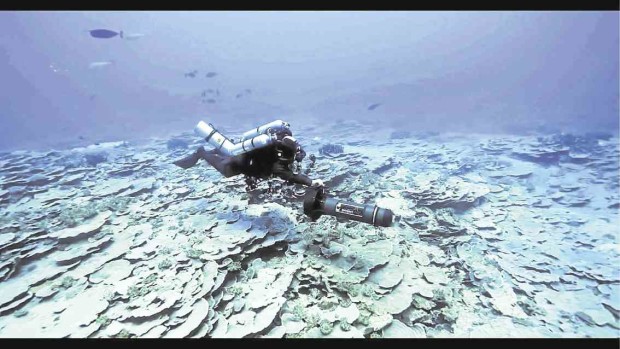Next miracle drug may come from PH seas, say scientists

OCEAN FLOOR WONDER A diver explores the spectacular marine biodiversity of Benham Rise, now renamed Philippine Rise, in this screen grab from a film by Oceana Philippines. —OCEANA VIDEO
BAGUIO CITY—The next miracle drug may come from the country’s seas, scientists here said last week.
“There are so many potential drugs which can come from the ocean. This is precisely the next frontier which we feel pharmaceutical drug discovery efforts should look into,” said Dr. Aaron Joseph Villaraza, associate professor at the University of the Philippines Institute of Chemistry in Diliman.
Speaking at the 39th Luzon session of the National Academy of Science and Technology here on May 16, Villaraza said medicines for pain relief or compounds used for cancer research had been synthesized from marine life found in the Philippines.
Rich biodiversity
The Philippines has a rich biodiversity, so the Smithsonian Institution based in Washington conducted in 2005 a survey of 2,983 shore fish species, according to Villaraza.
“In mapping out the geographic distribution, they found that most species are located in the center, [which is the] Verde Island passage between Mindoro and [mainland] Luzon.
“Waters from the Pacific Ocean flow toward the Philippines carrying herds of marine animals … . [These are] nutrient-rich waters creating all sorts of microenvironments, characterized by different kinds of nutrition … different kinds of ecology,” he said.
He added that it was “no surprise [to] find a very high degree of marine biodiversity in the center of the Philippines.”
Seaweeds
Researchers in the Ilocos region have also confirmed the medicinal properties of certain types of seaweed, said Andres Tungpala, dean of the College of Aquatic Science and Technology at Don Mariano Marcos State University.
Villaraza said drug development in the country was relatively new.
“It is a very long and very expensive [process]. One of the biggest challenges to transition from a drug in nature to something that is commercially available is the capacity to acquire the bioactive compounds (the biological compounds produced and which affect any organism) in sufficiently large amounts,” he said.
Ecological imbalance
Pharmaceutical companies are aware that constantly harvesting the organism that produces bioactive compounds could trigger an ecological imbalance, according to Villaraza.
So some companies invest heavily in total synthesis, a term for replicating the natural compounds by recreating complex organic molecules using chemical reagents, he said.
Some scientists try to reproduce the bioactive compounds by keeping live samples of the marine animal, he said. But they ended up hiring people to collect seawater from the organism’s original habitat when they discovered that the species kept in laboratories stopped producing the compounds.
But the seas are “a real resource we can take advantage of,” he said.














